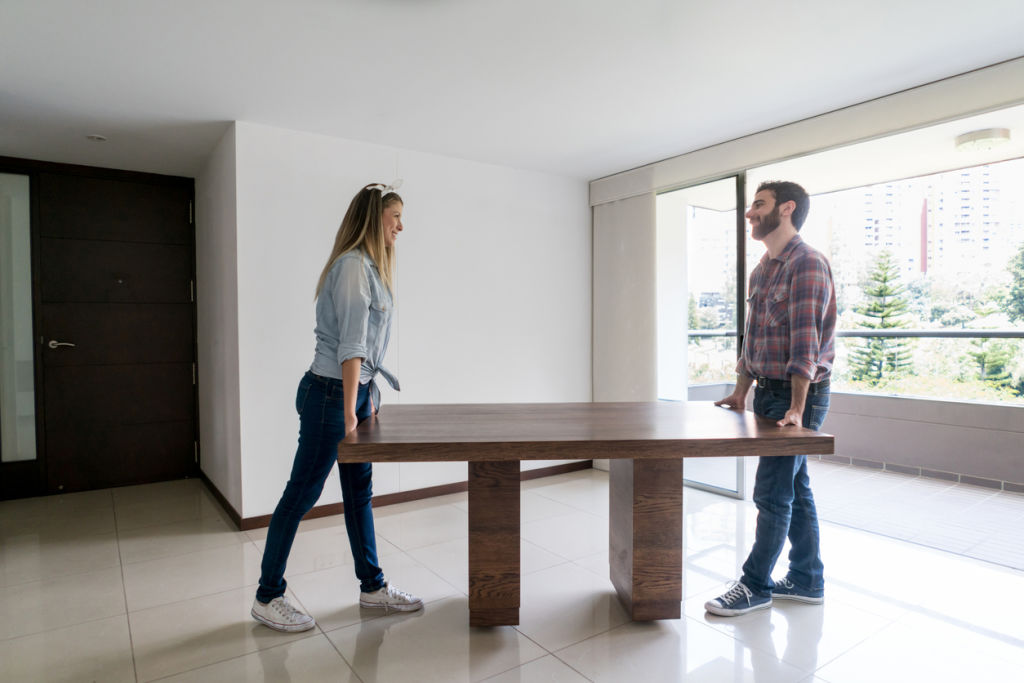'It's just a dining table': Why saying goodbye to your things is the hardest part of moving house

It’s just a dining table, honestly, for the sake of all that is wholly made of wood, what is wrong with you?
This is the question I asked myself as I sat, fortunately alone, in our increasingly empty house, staring at an inanimate piece of timber, and tearing up, ever so slightly.
I’d had this particular dining table for so long that I couldn’t even guess how much I’d paid for it, but I was pretty sure I hadn’t shopped for it using a smartphone because they didn’t exist back then.
What I did know was that it was worth a lot more than the $90 we’d agreed to sell it for. Unfortunately, when you are moving and you, or your far wiser partner, suddenly realise that none of your old furniture will “go” in your new house, a kind of purging madness overtakes you.
I’d never known this dining table, which was so solidly built that it weighed as much as an elephant with a camel on its back, to “go” anywhere, but I was trying to take some solace from the fact that we hadn’t just given it away for nix, as we had with our bed, a couch, a favourite chair and possibly as many as 85 of my stubbie holders that were suddenly deemed surplus to requirements.

People warn you that moving house is hard, but no one tells you in just how many unexpected ways it will hit you. Like a dining table falling on you.
It wasn’t just the good, solid and apparently ageless timber making this particular table so lumpen to lift; it was also packed with emotional weight, all of which was suddenly, somehow, pressing on my chest.
I knew that I’d bought it in a desperate and possibly foolish attempt to impress the woman who is now my wife. I thought that it might add a certain maturity and gravitas to the bachelor pad I was occupying at the time – certainly more than the posters of half-clad women and Pearl Jam, and the lack of any dining table at all.
I think, at least in my memory, that she was impressed, although I do recall that she hated the garish blue seats I’d chosen to (not) go with the table, and that she sold those years ago, probably for a fiver, and replaced them with chairs that I hate. The kind that look good but are as comfortable as sitting on a snake’s skeleton.

The dining table came with us – after some sweating and heaving – to our first, grown-up apartment together, then to our first tiny house, where it only barely fitted. And it was there that our son ate his first meals, in a high chair. Most of those meals were smeared across said table, as I recall.
But the table bit back, a few years later, when he was skylarking on a chair, fell and smashed his chin into its all-too-solid surface, opening up a Harrison Ford-like scar that would need stitches. And so, in part, the table was responsible for one of the worst moments of my life: holding down my little boy as they pushed a needle into his wound, his giant eyes looking at me with utter betrayal and shock.
A second child meant a larger house, yet still not so big that we had space to upsize our dining table, and so it became the place where, over a decade, countless family meals, Trivial Pursuit battles, Monopoly storm offs and Pictionary apoplexies played out. (I am, without question, the worst artist the world has ever seen, and whoever partners me is always left looking like a gasping fish.)
More than anything, though, what I associate with that table is the sound of laughter – the kind of ringing, tittering, uncontrollable mirth that falls out of small children, and then the deeper, boomier, rarer, and thus more valued – chuntering of teenagers.
How could I let it go? Sure, it would look like a card table in our new home’s living room, and we’d need to hire a crane to lift it, but surely it was approaching heirloom status by now?
Sadly not. When the delighted online shopper turned up to take it away he looked at me with some horror: “Are you sure? Just $90? The timber in it is worth more than that!”
Sniffling slightly, I told him that it mattered not what dollar figure he offered – to me that table was priceless. But if he insisted, he could have it for $100.
States
Capital Cities
Capital Cities - Rentals
Popular Areas
Allhomes
More










